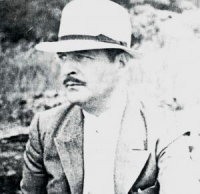Alan H. Leamy
U.S. automotive designer born in Arlington, Maryland, grew up in Columbus, Ohio. In 1905 he was stricken with polio, and was forced to wear a leg brace for the rest of his life. He had an early interest in cars and architecture, in which he took a correspondence course, and was an avid hunter. He was self-educated, reading widely in fields of music, literature, science, and medicine. He worked in real estate for eighteen months, until his father contacted a friend, who happened to be chief engineer at Marmon. In 1927 he obtained a position at the Marmon Motor Company in Indianapolis, but found the company too conservative for his interest in advanced designs.
In 1928 he was hired by Errett Cord to become chief stylist for the Auburn Automobile Company, which made Auburns, Cords, and Duesenbergs. His first job was to work on the Auburn Boattail Speedster of 1928 that included aircraft features including wicker seats, aluminum body, altimeter, and compass. He pioneered in the use of full-scale clay models in 1928 and 1929. Leamy probably made some contribution in the design of the famous Duesenberg Model J, which is credited primarily to Gordon Buehrig.
Leamy alone designed the first U.S. front-wheel drive car, the L-29 Cord. The Cord had a low chassis and a set-back radiator necessitated by the front wheel drive. The car was hailed by MoTor magazine as “the first really new automobile design to appear on the market for many years.” It was the best-selling Auburn of all time, and sold about 5,200 units up to 1932, when the Depression forced Cord to end production.
Leamy also up-dated the Auburn line, including the 1931 8-98 line, which in 1932 converted to a V-12 engine that added eight inches to the length, and the Auburn sixes and eights. He originated the center-split radiator design that changed radiator designs from simple rectangular boxes, to a rounded opening that looked like a ‘hole’ in the body.
In 1934, Leamy took a position as designer at GM’s Art & Color Department under Harley Earl. In 1935, he was promoted to chief stylist of the LaSalle Division. Sadly, after eight days on his new job, he died unexpectedly from a routine but contaminated medical injection.


